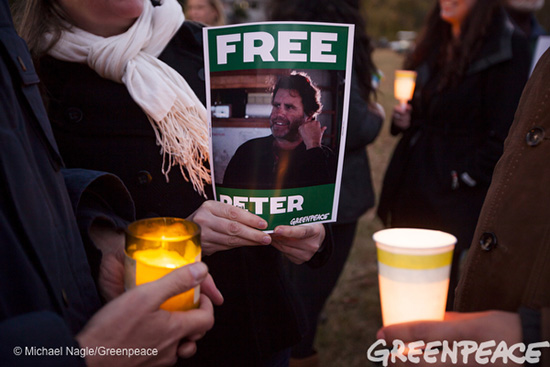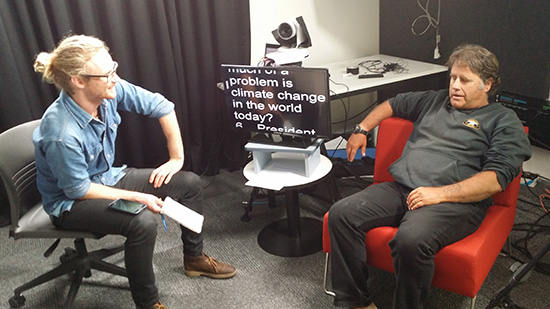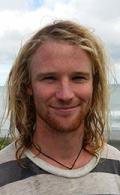Michael Neilson of the Pacific Media Centre
AUCKLAND (Pacific Media Centre/Pacific Media Watch): Following more than 30 years as a skipper for Greenpeace, Pete Willcox is as fired up as ever over his environmental work, even after facing a few adversaries along the way.
He was on board the first Rainbow Warrior when it was bombed on July 10, 1985, by French secret service agents at Marsden Wharf in Auckland Harbour; he was detained by Russia for 100 days as part of the “Arctic 30” for protesting against oil drilling in the Arctic; and he’s been arrested many times around the globe.
Rather than discourage him, these battles have only reinforced his resolve to fight for what he believes in.
Only a couple of years after joining Greenpeace, Willcox was skipper of the Rainbow Warrior during its final voyage through the South Pacific campaigning against nuclear testing.
The ship’s penultimate mission, helping transfer residents affected by nuclear radiation from the Rongelap Atoll in the Marshall Islands to Mejato Island, had a lasting impression on Willcox, as he told AUT Journalism’s Senka Bosnyak in an interview.
“Rongelap is something that will stay with me for the rest of my life… a lot of us considered it one of the high points of our Greenpeace careers, to be able to do something so fundamentally useful as get people to a safe place to live.”
It is experiences like these that keep the fight in Willcox alive, even when up against formidable opponents, and he has had his fair share.
Not backing down
Despite the trauma of the Rainbow Warrior bombing, which killed Dutch photographer, Greenpeace activist - and great friend - Fernando Pereira, the event only strengthened the fight in Willcox.
“When we got blown up by the French, a lot of people said, ‘Well, are you thinking about retiring now?’
“On the boat we were like, ‘If we’ve scared the government of France so badly they have set out to kill us we must be doing something right.’ And so none of us stopped.”
Willcox was also part of an international team, dubbed the “Arctic 30”, who were detained by Russian authorities for 100 days in 2013 for protesting against oil drilling in the Arctic.
Willcox says although he’d do it again for the risk of a few months in jail, the thought of 10 to 15 years in a cold, dark Russian jail cell scared him.
“We were in a judicial system where 99.9 percent of the people who are put in detention like we were are found guilty at trial. ‘You better start learning Russian, because you’re going to be here a while,’ the Russian authorities would tell us.
“I didn’t believe it, but I lost 11 kilograms in three weeks because of stress.”

Outside world
He didn’t speak to a lawyer or call his family for a month, and had no idea what was going on in the outside world.
“I just had faith Greenpeace was working like hell to get us out. I had no idea they’d pulled out all the stops and just went crazy.
“Looking back on it I think the person doing the arresting said, ‘Lock them away and let them smell the toilets for two months.’
“We knew they had a huge general amnesty coming up around Christmas, it was a pre-Sochi [Winter Olympics] thing, and we knew Putin wanted Sochi to go perfect.”
Either the Rainbow Warrior bombing or the Arctic 30 experience would be enough to frighten most from pursuing their causes, but not Willcox.
“We are not backing down,” he says.
In fact just four months after they were released, Willcox was arrested in Rotterdam protesting against a supply of oil coming down from the very rig they had protested.
Climate change
Having played a crucial role in the campaigns against nuclear testing in the South Pacific, today his focus is on climate change.
“The reason I am fighting is that I would like to see us do as little damage as possible. I do not want to see the death rates go up to five million in Africa because of droughts.
“I do not want to see 20 million people die in Bangladesh because of a storm that comes in and wipes the place out.”
While there are many similarities between the anti-nuclear and climate change campaigns, Willcox says climate change is a different beast.
“The anti-nuclear campaign was, ‘If we don’t blow it we’ll be alright,’ but there is no getting away from global warming. It is getting us right now."
Willcox says it has been difficult to get widespread support in the campaign, and only as people begin to see and experience its damaging effects are they begginning to come on board.
“The more screwed up the world gets, the more traction we get.”
Mighty adversary
Though as they gain support, they are also gaining a mighty adversary: the fossil fuel industry.
“They know what’s going on. They are not stupid, but they do not care, they want to make money. And they want to make just as much as they can before they get shut down.”
Willcox and Greenpeace have been up against this adversary in getting their next campaign in Australia underway.
“We were physically kept out of Australia by the coal industry for the last six months. The government was doing the dirty work. We sat at anchor in Sydney for a month, picking our noses.”
Australia is seeking to double its coal exports by opening up huge coal reserves in Central Queensland to mining.
To account for the increase in exports, hundreds of extra ships will pass through the Great Barrier Reef World Heritage Area, and millions of tonnes of seafloor will be dredged up to construct coal port extensions.
Due to the drop in price of coal, Willcox believes their campaign to stop the coal expansion will be successful.
“I do not think they are going to double the coal exports in Australia. The price of coal, especially when the Saudis cut the price of oil, is going down.
“Nobody is going to want to buy it. Banks are not going to give loans to build the terminals – there is just not the market for coal anymore.”
New direction
Following its mission to the Great Barrier Reef, Greenpeace will return to Auckland on July 22 until August 1 to get the Rainbow Warrior III I ready for its tuna campaign.
Willcox says he is excited about the two month campaign ahead.
“In addition to simply researching the fishery that is going on, we’re also examining the living conditions of the crews, who are in many cases, kept in near slavery type conditions.
“I think it is a great thing for Greenpeace to be getting involved in, more on a human rights level, condemning the fisheries for treating people like shit. I’m really glad we’re doing that.
“It’s such a good step for Greenpeace to take more interest in the human rights side of it, not just counting the fish that coming on board, but checking out the poor guys out there on sub-standard wages.”

A TALE OF RAINBOW WARRIOR BOOKS
Rainbow Warrior skipper Pete Willcox commends Professor David Robie on his 30th anniversary edition of Eyes of Fire, a book on the Rainbow Warrior’s last voyage through the South Pacific and its subsequent bombing in Auckland.
It is being launched tomorrow at The Cloud in Auckland’s port, just a stone’s throw from where the ship was sabotaged on July 10, 1985.
“David’s book was brilliant. He was on the boat the last three months. He wasn’t interviewing people – he was living it.
“That’s where we became friends. He’s led a fascinating life, and it’s an education to sit and talk to him.”
Willcox also recommends one of Dr Robie’s other books, Don’t Spoil My Beautiful Face, to those interested in South Pacific issues.
“Every Greenpeace campaigner in the Pacific should read that book. It’s such a history.”
Willcox himself has an autobiography coming out in April next year, which covers much of his life, how he got involved in Greenpeace, and some of their most interesting campaigns.
He wrote the book six years ago, but faced trouble getting it published, until his experience in Russia.
“I owe it all to my buddy Vladmir Putin. I wasn’t getting any traction, then I came back from Russia and I called my agent, and he said, ‘Come in tomorrow.’ And it sold, just like that.
“Putin will be in the acknowledgements, for sure.” - Michael Neilson
Video below: Senka Bosnyak talks to Rainbow Warrior skipper Pete Willcox



